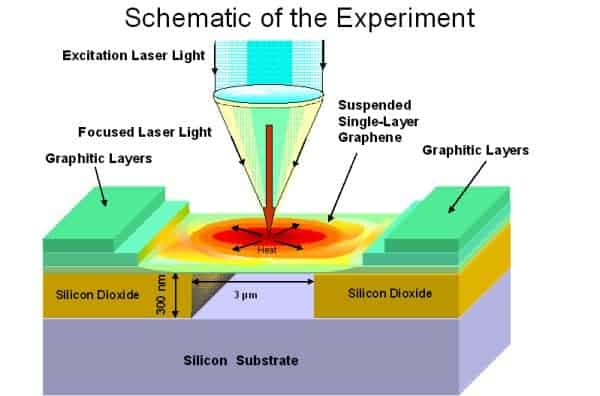
Is there anything that graphene—sheets of carbon just one atom thick — can’t do? Since this wonder material was disovered in 2004, it has been shown to be an extremely good electrical conductor; a semiconductor that can be used to create transistors; and a very strong material that could be used to make ultra thin membranes. Now, researchers in the US have confirmed that graphene is also a very good conductor of heat.
The team, which had to invent a new way to measure thermal conductivity in order to study the material, is now investigating how graphene’s thermal properties could be used to cool ultrafast silicon chips (Nano Letters 10.1021/nl0731872).
Physicists had suspected that graphene can conduct heat very well because carbon nanotubes, which are essentially graphene rolled into tiny tubes, are themselves very good thermal conductors. However, graphene can be very difficult to work with and researchers had struggled to determine its thermal properties using traditional techniques that involve attaching heaters and other devices to the material.
Raman scattering
Alexander Balandin and colleagues at the University of California-Riverside have instead devised a new measurement technique that uses a laser to both heat the graphene and measure its temperature. The team suspended sheets of graphene across micrometre-wide trenches cut into a silicon-oxide surface. The sheets were several micrometres long and were pinned-down at both ends by layers of graphite, which acted as heat sinks.
The centre of the sheet is then exposed to a beam of laser light, which heats the graphene and changes the frequencies at which its carbon atoms vibrate. Some of the laser light changes frequency as it undergoes Raman scattering off the vibrating atoms and the size of the frequency shift is proportional to the temperature of the illuminated region.
Frequency shift
By measuring the frequency shift — and hence the temperature of the graphene — as a function of laser power, the team was able to calculate the thermal conductivity of graphene, which was found to be a whopping 5300 W/(m K) at room temperature. This is the highest known value of any solid — 50% higher than carbon nanotubes and more than ten times greater than metals like copper and aluminium.
Balandin told physicsworld.com that the team were surprised to find that graphene is a much better conductor of heat than carbon nanotubes — even though some theoretical work had suggested that this could be possible.
Graphene’s high thermal conductivity is probably a result of the relative ease with which atomic vibrations can move through graphene compared to other materials. Balandin and collegues are now working on a theory that explains why this is so.
Balandin believes that graphene’s high thermal conductivity, flat shape and ability to be integrated with silicon means that it could play an important role in removing heat from electronics devices. The team are also working on the design of graphene-cooled ultrafast transistors.



